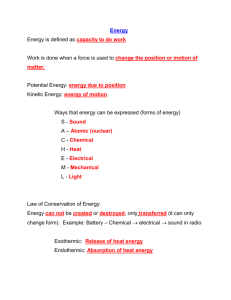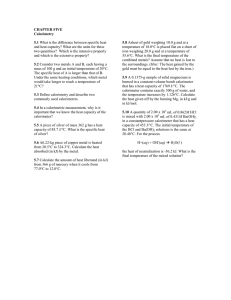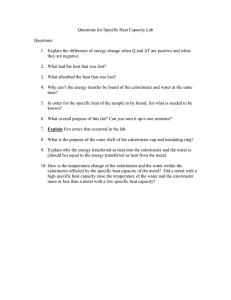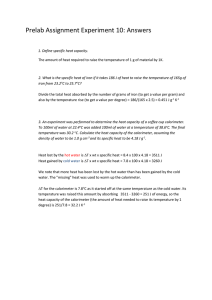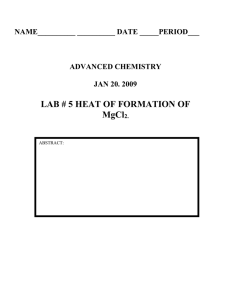Calorimetry is the measurement of heat changes in physical and
advertisement
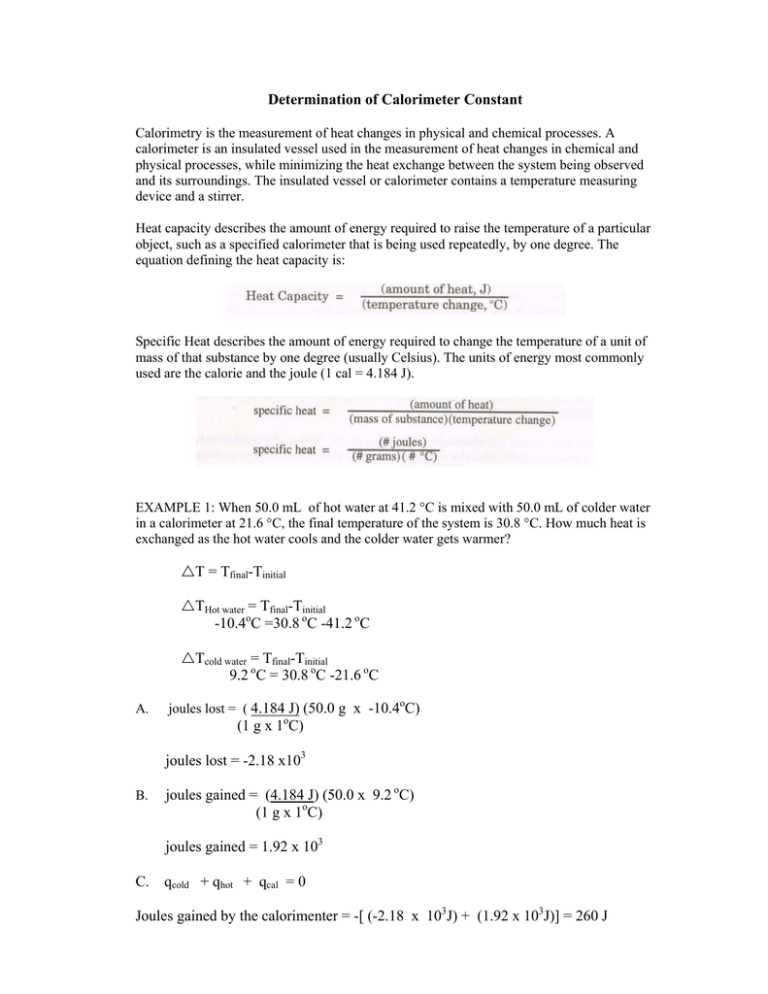
Determination of Calorimeter Constant Calorimetry is the measurement of heat changes in physical and chemical processes. A calorimeter is an insulated vessel used in the measurement of heat changes in chemical and physical processes, while minimizing the heat exchange between the system being observed and its surroundings. The insulated vessel or calorimeter contains a temperature measuring device and a stirrer. Heat capacity describes the amount of energy required to raise the temperature of a particular object, such as a specified calorimeter that is being used repeatedly, by one degree. The equation defining the heat capacity is: Specific Heat describes the amount of energy required to change the temperature of a unit of mass of that substance by one degree (usually Celsius). The units of energy most commonly used are the calorie and the joule (1 cal = 4.184 J). EXAMPLE 1: When 50.0 mL of hot water at 41.2 °C is mixed with 50.0 mL of colder water in a calorimeter at 21.6 °C, the final temperature of the system is 30.8 °C. How much heat is exchanged as the hot water cools and the colder water gets warmer? UT = Tfinal-Tinitial UTHot water = Tfinal-Tinitial -10.4oC =30.8 oC -41.2 oC UTcold water = Tfinal-Tinitial 9.2 oC = 30.8 oC -21.6 oC A. o joules lost = ( 4.184 J) (50.0 g x -10.4 C) (1 g x 1oC) joules lost = -2.18 x103 B. joules gained = (4.184 J) (50.0 x 9.2 oC) (1 g x 1oC) joules gained = 1.92 x 103 C. qcold + qhot + qcal = 0 Joules gained by the calorimenter = -[ (-2.18 x 103J) + (1.92 x 103J)] = 260 J Heat Capacity of calorimeter = (260 J) = 28 J o o C (9.2 C) Therefore the calorimeter absorbed 250 joules for a 9.2 °C change (the calorimeter was the same temperature as the cooler water) or 27 joules/oC. If we use the same calorimeter each time, we do not have to weigh it to determine its specific heat—it will absorb the same o amount of heat/ C each time. This energy value is called the heat capacity of the calorimeter. You will use the heat capacity of your calorimeter to correct for the heat absorbed or given up by the calorimeter during the changes. PROCEDURE A. Construction and calibration of calorimeter 1. Obtain the components of a calorimeter: two nested Styrofoam cups fitted with a cover and a thermometer. Schematic of a "coffee cup" calorimeter No stir wire will be used for this experiment. 2. Get a second thermometer to measure the temperature of other liquids. 3. Set up the calorimeter as shown in the figure above. Practice reading your thermometer by measuring the temperature of water before you do the experiment. 4. Will both thermometers give identical readings? Measure the temperature of 25mL of water with thermometer #1. Record this temperature as T1. 5. Use thermometer #2 to measure the temperature of the water. Record this temperature as T2. Record the difference in temperature (T1 - T2 = ∆T). (NOTE: The difference in the temperature readings will be used to correct temperature changes when solutions or substances are mixed.) Label the thermometers so you can distinguish them. B. Heat capacity of calorimeter. 1. Use a graduated cylinder to carefully measure 25.0 mL of water into your calorimeter. Place the cover on the calorimeter and insert the thermometer #1 through the hole in the cover into the water. 2. Wait for about 5 minutes for the temperature to equalize. Record the temperature of the cold water. Continue with Step 3 while you are waiting. 3. Heat approximately 30 mL of water to about 50 °C in a 100 mL beaker. Turn off the hotplate; then carefully set the hot water and beaker on the desktop. 4. Use your graduated cylinder to carefully measure 25.0 mL of the hot water. 5. Measure the temperature of the hot water with thermometer #2 and record it. 6. Quickly remove the cover, pour the 25.0 mL hot water into the calorimeter with the cold water and replace the cover of the calorimeter and thermometer #1. 7. Measure and record the temperature of the 50.0 mL of water in the calorimeter every ten seconds until a maximum is reached and then every 30 sec for a total of 3 minutes. 8. Plot the data on a piece of graph paper with the first point being the temperature of the water in the calorimeter before adding the hot water. Determine what the temperature should be for mix time by extrapolation. 9. Calculate the heat lost by the hot water, the heat gained by the cold water and the Heat Capacity of the calorimeter. Data Sheet Part A. Calibration of Thermometer Temperature of thermometer T1 _____________ T2 ________________ T1 - T2 = temperature correction ___________________ Part B. Determination of Calorimeter Constant Initial temperature of cold water and calorimeter _____________________ Volume of cold water _____________________ Initial temperature of hot water _____________________ Volume of hot water _____________________ Time in Seconds -10 Mix time 0 10 20 30 40 50 60 70 80 90 100 110 120 130 140 150 160 170 180 Temperature Joules lost by the hot water ______________________ Joules gained by the cold water ______________________ Heat capacity of the calorimeter J/oC ______________________

